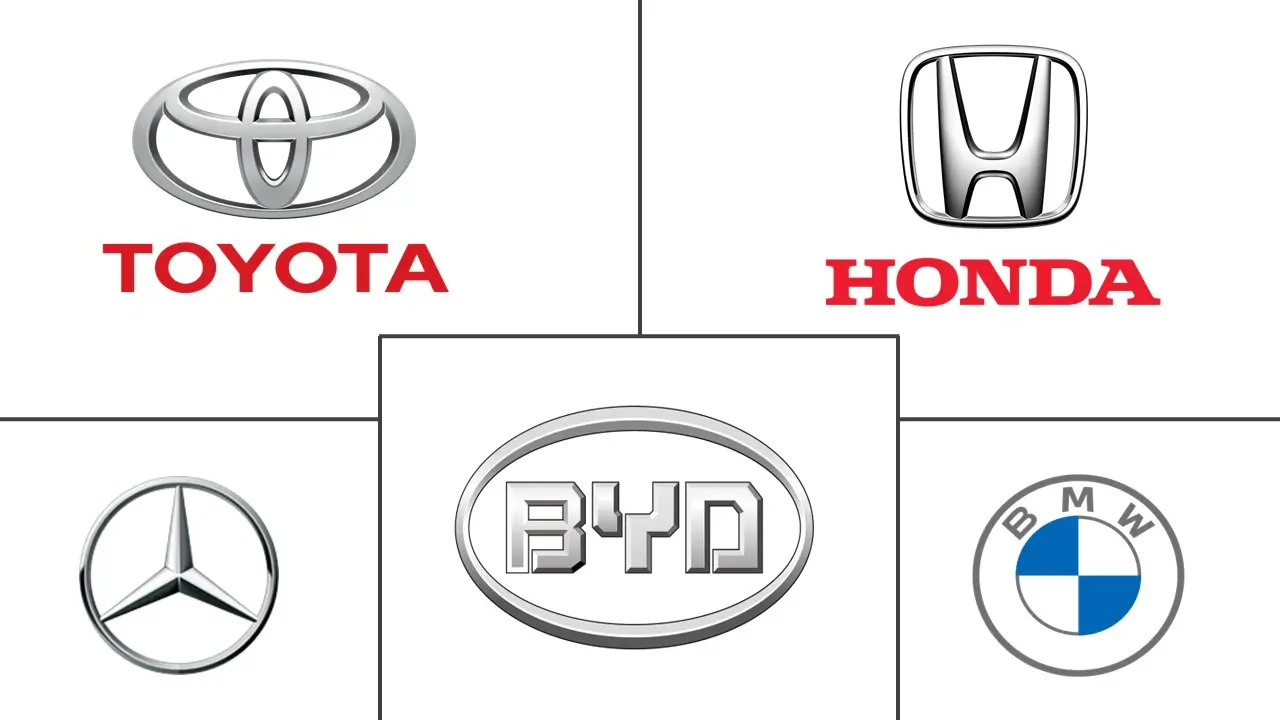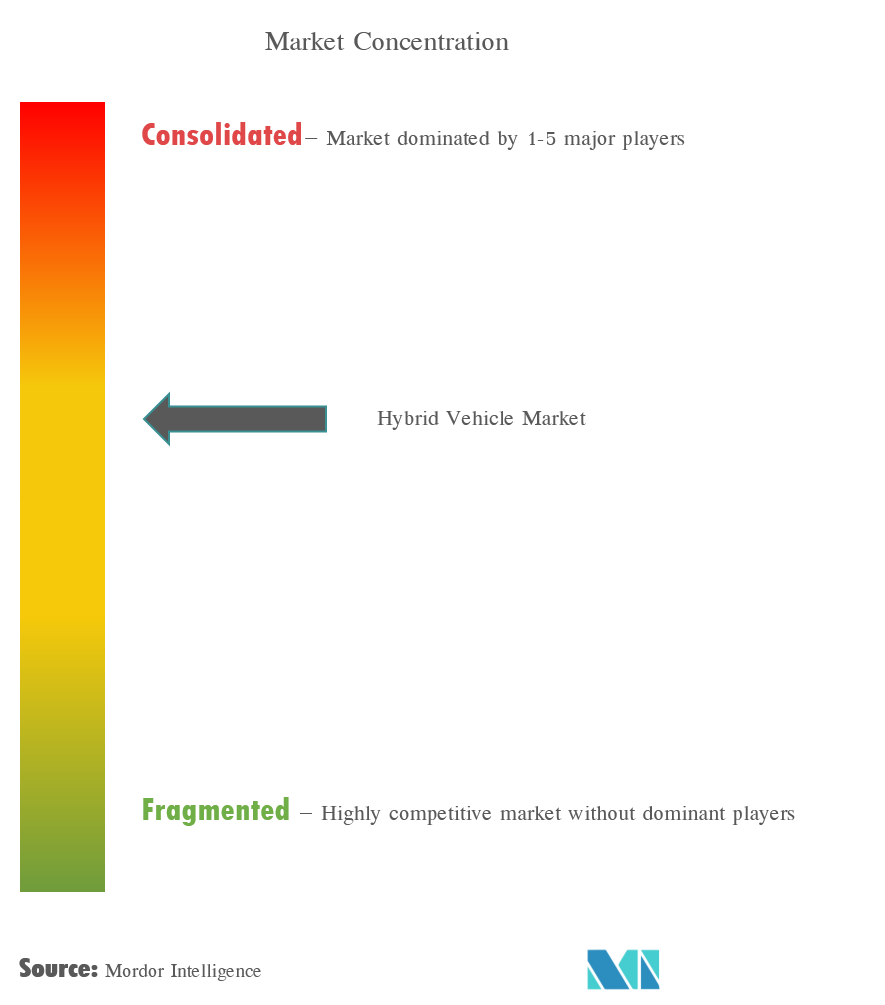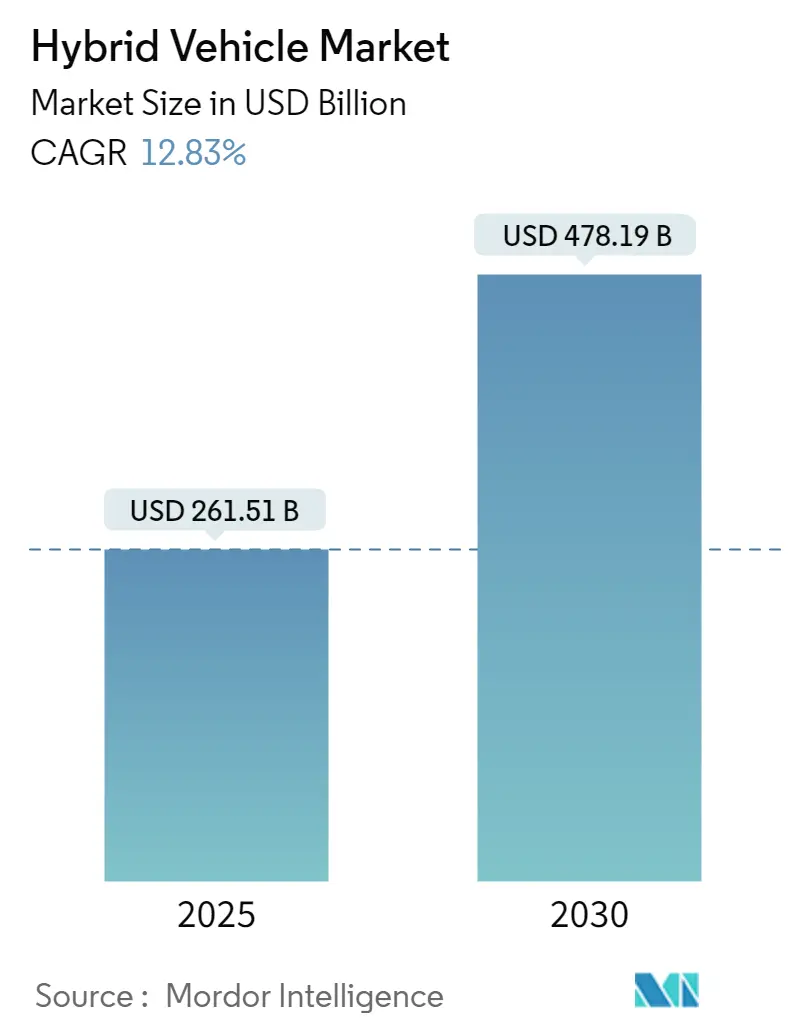
Hybrid Vehicle Market Analysis
The Hybrid Vehicle Market size is estimated at USD 261.51 billion in 2025, and is expected to reach USD 478.19 billion by 2030, at a CAGR of 12.83% during the forecast period (2025-2030).
- The COVID-19 pandemic positively impacted the hybrid vehicle market as the pandemic has crystallized attitudes toward the environment by revealing cleaner air and lower pollution levels during the lockdown. COVID-19 increased their environmental awareness, and these concerns are now reflected in intentions to purchase more sustainable electric and hybrid vehicles. The forecast period is expected to be optimistic as manufacturers plan to launch new models to attract customers. For instance, in November 2022, Toyota Australia announced several updates to its popular Corolla hatch and sedan lineups, including Toyota Connected Services functionality and the latest-generation hybrid powertrain.
- Over the long term, some of the major factors driving the market's growth are the enactment of stringent emission and fuel economy norms and government incentives for promoting the purchase and adoption of hybrid vehicles. Additionally, with governments taking stringent actions in the form of regulation and incentives, along with the increased initiatives for the provision of public charging stations for electric vehicles, the hybrid vehicle market is expected to grow at a high rate.
- For instance, in February 2022, According to the government of India, the subsidy under the Faster Adoption and Manufacturing of Hybrid and Electric Vehicles (FAME) program for fiscal 2023 is expected to be INR 2,908 crore (USD 351 million), which is more than three-and-a-half times the allocation of INR 800 crore (USD 96.5 million) for this fiscal year and nearly nine times the allocation for FY21.
- Major players in the hybrid vehicles market, such as BYD, Toyota, Nissan, Honda, Kia, and Hyundai, their active engagement in this segment creates a positive environment in the market. For instance, November 2022: Kia China announced that its EV6 compact battery electric SUV was on display at the CIIE and would be available in China in 2023. Kia will also launch 5 hybrid models in China in succession by 2026, beginning with the HEV model of the 5th generation Sportage compact SUV.
Hybrid Vehicle Market Trends
Passenger Car is Anticipated to Register Highest Growth
- Governments are offering many subsidies (tax rebates and incentives) for customers purchasing electric and hybrid vehicles globally. For instance,
- in November 2022, The Ministry of Industry and Information Technology (MIIT), China, published a "Catalog of New Energy Models Exempt from Vehicle Purchase Tax" on its official website. The plug-in hybrid models chosen include 14 passenger vehicles (such as Chery's Dasheng and Great Wall Motor's Mocha PHEV), three buses, four trucks, and eight specialty vehicles.
- Demand for hybrid vehicles is increasing in developing countries such as Brazil, India, and Mexico due to strict emission regulatory rules and a growing need for low or zero-emission vehicles. The Brazilian government is cutting taxes on hybrid vehicles such as plug-in hybrids, hybrid electric vehicles, and CNG hybrids. Similarly, the Indian government has announced that its well-known FAME II program will be extended until 2024 in order to promote electric mobility throughout the country. Major key players are also planning to participate in the country's green drive. For instance, in March 2022, Toyota Motor confirmed plans to increase its participation in India's green mobility segment, with the company preparing to launch a number of hybrid vehicles in the coming years. The first of these products, which will be manufactured locally, will hit the market next year.
- Governments in the United States and Europe are also focusing on lowering emission limits to reduce the greenhouse gas effect and improving vehicle fuel economy. For example, the US Department of Transportation has established Corporate Average Fuel Economy (CAFE) standards for vehicles. The United Kingdom committed to achieving net-zero emissions by 2050 and proposed a 2035 ban on selling all polluting vehicles. Germany intends to reduce greenhouse gas emissions by 40% by the end of 2020, 55% by the end of 2030, and up to 95% by the end of 2050, supporting market growth.
- In the Gulf region, electric and hybrid modes of transportation are gaining traction, particularly in Israel, Oman, Jordan, Saudi Arabia, and the United Arab Emirates. For example, In accordance with the Dubai Taxi Corporation's Strategic Plan 2021-2023, The Roads and Transport Authority (RTA) of Dubai has announced the signing of a contract for the procurement of 2,219 new vehicles to supplement the fleet of the Dubai Taxi Corporation. The new batch includes 1,775 hybrid vehicles, bringing the fleet's total number of hybrid vehicles to 4,105.
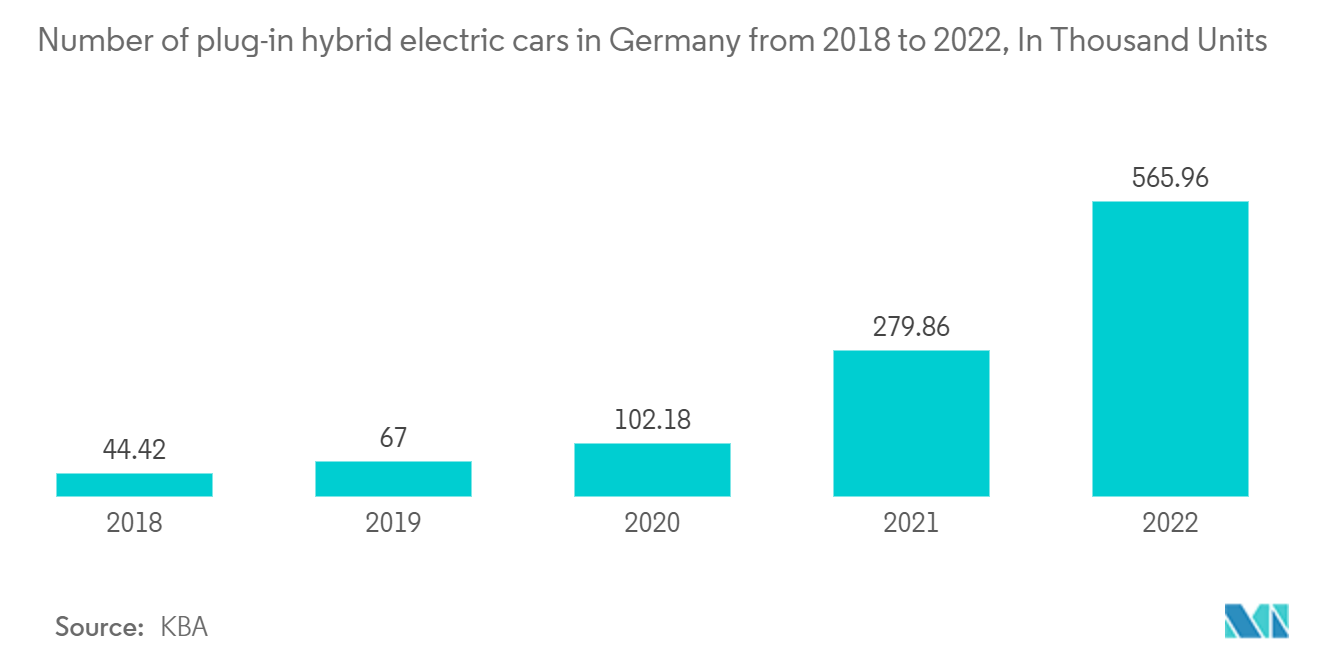
China to Play a Key Role in the Development of the Hybrid Vehicle Market in Asia Pacific
- The Asia-Pacific hybrid vehicle market is expected to grow during the forecast period. Increased demand for hybrid vehicles in China, Japan, and South Korea are driving market growth in this region.
- China is a significant player in the global hybrid electric vehicle market due to its significant production capabilities and consumer demand. Following the pandemic, China gained momentum, and demand for hybrid and plug-in hybrid electric vehicles started seeing positive trends.
- For instance, in October 2022, The wholesale volume of NEV passenger cars was 676,000 units, up 85.8% year on year. Battery electric vehicle (BEV) volumes increased by 69.6% year on year to 508,000 units; plug-in hybrid electric vehicle (PHEV) volumes increased by 161.6% year on year to 167,000 units, and ICE-powered hybrid passenger vehicle volumes increased by 9% year on year to 67,362 units.
- The Chinese government provides numerous subsidies (tax breaks and incentives) to customers who purchase electric and hybrid vehicles. The Chinese government recently introduced measures to support the new energy vehicle (NEV) industry, which was hard hit by the COVID-19 outbreak, by extending tax exemptions and subsidies that were set to expire by 2020 and hinting at new investments that could further boost the country's hybrid electric vehicle market in the long run.
- During the forecast period, the country may also see an increase in the adoption of hybrid electric buses, as more than 30 Chinese cities, including Guangzhou, Dongguan, Zhuhai, Foshan, and Zhongshan in the Pearl River Delta, as well as Nanjing, Hangzhou, Shaanxi, and Shandong, have made plans to achieve 100% electrified public transportation. All of the aforementioned factors and developments are expected to help China stand out as a unique destination for manufacturer investments and play a significant role in the overall growth of the hybrid vehicle market over the forecast period.
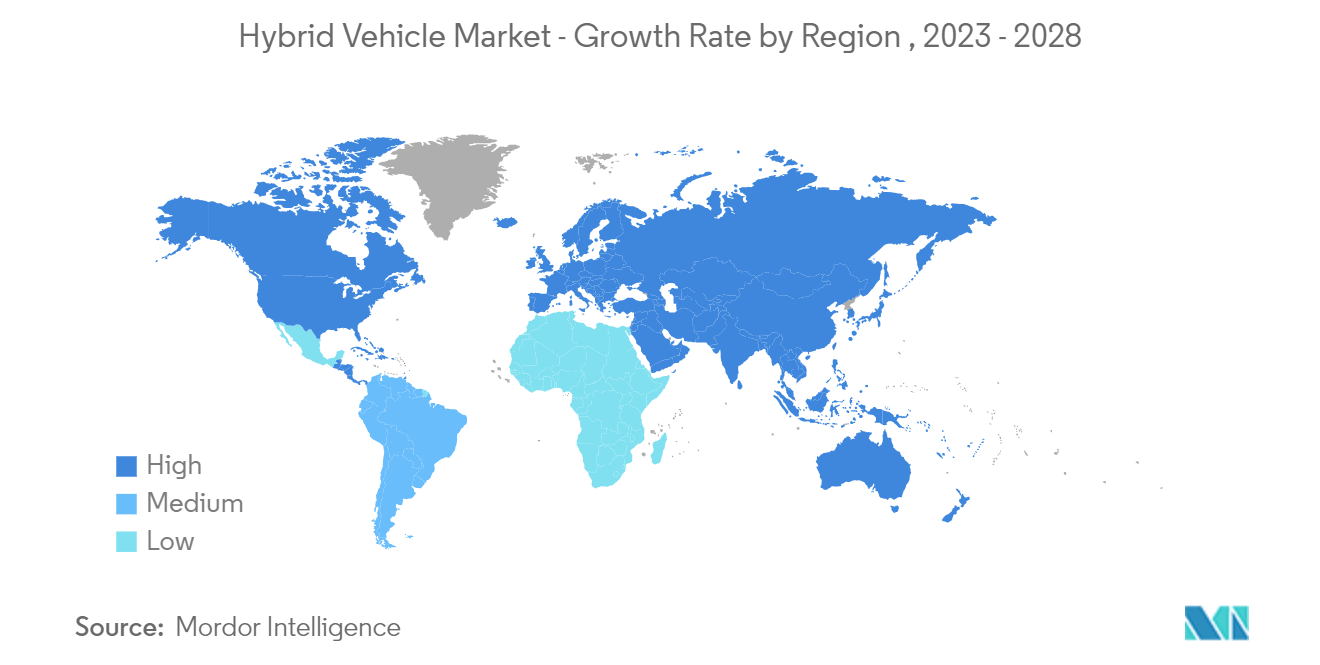
Hybrid Vehicle Industry Overview
Some of the key players operating in the hybrid vehicles market are Ford Motor Company, General Motors Company, Honda Motor Co., Ltd, Daimler AG, and Volkswagen AG, which are also planning to provide enhanced product portfolios and technological breakthroughs in the hybrid vehicles market. For instance,
In November 2022, Mitsubishi Motors Corporation announced that the plug-in hybrid electric vehicle (PHEV) model of the all-new Outlander crossover SUV would be available in Canada and the United States. The new model provides the practicality and powerful ride expected of an SUV in various weather and road conditions, a safe ride unique to an electrified vehicle.
In October 2022, Daihatsu Motor Co., Ltd intended to release a hybrid minivan in the fall of 2023. The series hybrid system used in the compact hybrid vehicle (HV) Rocky will be significantly improved for mini vehicles to achieve a fuel efficiency of 30 kilometers per liter (WLTC mode) or higher, which would be among the best in the micro-mini class.
Hybrid Vehicle Market Leaders
-
Toyota Motor Corporation
-
Honda Motor Company Ltd
-
BYD Co.Ltd
-
Mercedes-Benz Group
-
BMW AG
- *Disclaimer: Major Players sorted in no particular order
Hybrid Vehicle Market News
- November 2022: Toyota South Africa Motors (TSAM) announced the importation of several RAV4 Plug-In Hybrid Vehicles (PHEV) to test customer response, vehicle behavior, infrastructure requirements, and other technical aspects, as well as educate customers on plug-in technology. It is also the second phase of TSAM's New Energy Vehicle (NEV) roll-out strategy, following the hybrid vehicle expansion strategy across Toyota's mainstream product lines.
- November 2022, The Almaz Hybrid, previously displayed at the Indonesia Electric Motor Show (IEMS) 2022 event, was officially launched by Wuling Motors in Indonesia.
- October 2022,: BYD announced that it had opened its first store in Brasilia, Brazil's capital, in collaboration with Saga Group, the country's largest dealer. In Brazil, BYD has introduced the Tang EV luxury battery-electric SUV, the Han EV battery-electric sedan, the D1, and the Song PLUS DM-i hybrid SUV, which will go on sale soon.
- In October 2022, Korea Fuel-Tech Corporation invested USD 10 million in the construction of a new plant in Auburn, Alabama, the United States. The new plant will produce carbon canisters and hybrid vehicle fuel systems.
Hybrid Vehicle Industry Segmentation
Hybrid vehicles are powered by an internal combustion engine and an electric motor, which uses energy stored in batteries. The battery is charged through regenerative braking and by the internal combustion engine.
The hybrid vehicle market has been segmented by hybrid type, vehicle type, and geography. By hybrid type, the market is segmented into micro-hybrid, mild-hybrid, full-hybrid, and plug-in hybrid. By vehicle type, the market is segmented into passenger cars and commercial vehicles.
By geography, the market is segmented into North America, Europe, Asia-Pacific, and the Rest of the world.
The report offers market sizes and forecasts in value (in USD) for all the above segments.
| By Hybrid Vehicle Type | Micro-hybrid | ||
| Mild-hybrid | |||
| Full-hybrid | |||
| Plug-in Hybrid | |||
| By Vehicle Type | Passenger Cars | ||
| Commercial Vehicles | |||
| By Geography | North America | United states | |
| Canada | |||
| Rest of North america | |||
| Europe | Germany | ||
| United Kingdom | |||
| France | |||
| Italy | |||
| Norway | |||
| Netherlands | |||
| Rest of Europe | |||
| Asia-Pacific | China | ||
| India | |||
| Japan | |||
| South Korea | |||
| Rest of Asia-Pacific | |||
| Rest of the World | South America | ||
| Middle-East and Africa | |||
Hybrid Vehicle Market Research FAQs
How big is the Hybrid Vehicle Market?
The Hybrid Vehicle Market size is expected to reach USD 261.51 billion in 2025 and grow at a CAGR of 12.83% to reach USD 478.19 billion by 2030.
What is the current Hybrid Vehicle Market size?
In 2025, the Hybrid Vehicle Market size is expected to reach USD 261.51 billion.
Who are the key players in Hybrid Vehicle Market?
Toyota Motor Corporation, Honda Motor Company Ltd, BYD Co.Ltd, Mercedes-Benz Group and BMW AG are the major companies operating in the Hybrid Vehicle Market.
Which is the fastest growing region in Hybrid Vehicle Market?
Asia-Pacific is estimated to grow at the highest CAGR over the forecast period (2025-2030).
Which region has the biggest share in Hybrid Vehicle Market?
In 2025, the Asia-Pacific accounts for the largest market share in Hybrid Vehicle Market.
What years does this Hybrid Vehicle Market cover, and what was the market size in 2024?
In 2024, the Hybrid Vehicle Market size was estimated at USD 227.96 billion. The report covers the Hybrid Vehicle Market historical market size for years: 2019, 2020, 2021, 2022, 2023 and 2024. The report also forecasts the Hybrid Vehicle Market size for years: 2025, 2026, 2027, 2028, 2029 and 2030.
Our Best Selling Reports
Hybrid Cars Industry Report
The global insurance third-party administrator (TPA) market is experiencing significant growth, driven by the increasing demand for efficient claims processing and administrative services in the insurance industry. TPA insurance companies serve as intermediaries between insurance companies and policyholders, ensuring seamless claim settlements and operational efficiency. The Insurance TPA market is segmented by service type, end user, enterprise size, and region. Service types include claims management, policy management, and commission management, among others. End users are divided into life and health insurance, and property and casualty insurance, with further subdivisions in health insurance.
The market caters to both large enterprises and small and medium-sized enterprises (SMEs), with large enterprises currently dominating due to their high volume of insurance policies and claims. Technological advancements, such as automation, artificial intelligence, and data analytics, are enhancing TPA services, creating numerous opportunities for TPA market size expansion. The adoption of advanced technologies and strategic partnerships are expected to drive the TPA market forward.
Statistics for the Insurance Third Party Administrators market share, size, and revenue growth rate, created by Mordor Intelligence™ Industry Reports, include a market forecast outlook and historical overview. Get a sample of this industry analysis as a free report PDF download.

